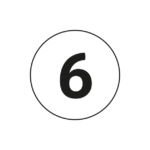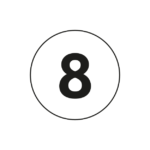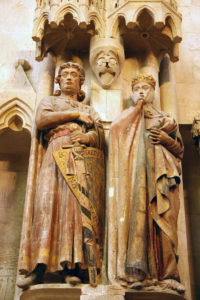ARCHEOLOGY


« Rouen » tripod pitcher
- Early 14th century
- Glazed earthenware
- Ht. 22cm
- Guy Dubois Collection, Rouen
Yellow and ochre lead-glazed earthenware decorated with stripes, tear drops and flowers.
This jug was particularly used to serve wine. It has a rounded belly and a narrow neck decorated with ribbing.

Pearl, ornamental ring
Floral decorations for fabrics
- Medieval period
- Copper alloy
- Penne Castle – courtyard area

Ornamental buckles
- From 10th to 14th century
- Copper, iron and silver alloy
- Penne Castle – courtyard and bastion area
Set of buckles for belts and ribbons.
The D-shaped, damascened* silver buckle fragment (2nd from the left) is the only medieval object definitely dating from the 10th century, and the oldest found in Penne.
* Small metal threads (silver, gold, copper) inlaid when cold with a hammer and forming a decoration inside another metal (iron, steel, copper).

Rings and pearls
- Medieval period
- Copper alloy
- Penne Castle

Pins, thimble and aglets
- 16th-17th century
- Copper and gilded bronze alloy
- Penne Castle – courtyard area
Accessories used in dressmaking. An aglet is a small metal broach attached to the end of a shoelace, ribbon or to a cloth or leather belt or cord. It was used to fix and adjust the length of a range of military and civilian garments and prevent them from fraying.

Sewing needle*
- Medieval or modern period
- Bone
- Penne Castle – courtyard area
* Needle with a hole pierced at the flattened top for the thread.

Plated garment
- 13th-14th
- Gilded bronze
We can see two figures, Adam and Eve, with the Tree of Life in the centre.

Belt buckles
- 13th-14th century
- Copper alloy
- Penne Castle – courtyard area
Small bars with holes at each corner that went through the belt width-ways at regular intervals to prevent the material from folding up and for a decorative effect.

Full-length statues of Eckard II of Meissen and his wife Uta von Ballenstedt, 13th century, Naumburg, Germany.
We can see the buckles on Eckard II’s belt.

Jew’s harp
- 14th century
- Iron
- Penne Castle – archway area
This is a type of Jew’s harp that was found far and wide in Europe in the 14th century. The ends of the blade, which is bent into a ring shape, are placed between the lips. A reed is inserted into the middle of the blade. The musician makes it vibrate with his index finger.

Ornament chest
- 1440-1470
- Wood, bone (plates), brass
- Flanders
Due to its fine decoration and the rich materials (bone), this chest is thought to have been a wedding or courtship gift.
A chest with low relief decoration featuring holy figures and biblical scenes.
Underneath is a chessboard made of ebony and bone. The hinges and rings are made of brass

Dice
- Medieval period
- Bone
- Penne Castle – archway area
Six-sided dice marked with pointed ocelli*.
* A round pattern with the centre a different colour from the outer area.

